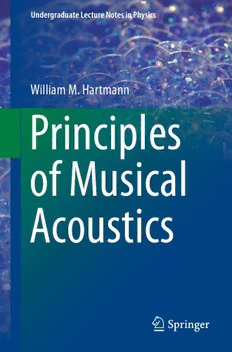
Principles of musical acoustics PDF
Preview Principles of musical acoustics
Undergraduate Lecture Notes in Physics William M. Hartmann Principles of Musical Acoustics Undergraduate Lecture Notes in Physics Forfurthervolumes: http://www.springer.com/series/8917 UndergraduateLectureNotesinPhysics(ULNP)publishesauthoritativetextscoveringtopics throughout pure and applied physics. Each title in the series is suitable as a basis for undergraduateinstruction,typicallycontainingpracticeproblems,workedexamples,chapter summaries,andsuggestionsforfurtherreading. ULNPtitlesmustprovideatleastoneofthefollowing: • Anexceptionallyclearandconcisetreatmentofastandardundergraduatesubject. (cid:129) Asolidundergraduate-levelintroductiontoagraduate,advanced,ornon-standardsubject. (cid:129) Anovelperspectiveoranunusualapproachtoteachingasubject. ULNPespeciallyencouragesnew,original,andidiosyncraticapproachestophysicsteaching attheundergraduatelevel. ThepurposeofULNPistoprovideintriguing,absorbingbooksthatwillcontinuetobethe reader’spreferredreferencethroughouttheiracademiccareer. SeriesEditors NeilAshby Professor,ProfessorEmeritus,UniversityofColoradoBoulder,CO,USA Professor,WilliamBrantley FurmanUniversity,Greenville,SC,USA MichaelFowler Professor,UniversityofVirginia,Charlottesville,VA,USA MichaelInglis Professor,SUNYSuffolkCountyCommunityCollege,Selden,NY,USA ElenaSassi Professor,UniversityofNaplesFedericoII,Naples,Italy HelmySherif Professor,UniversityofAlberta,Edmonton,AB,Canada William M. Hartmann Principles of Musical Acoustics 123 WilliamM.Hartmann MichiganStateUniversity EastLansing,MI,USA ISSN2192-4791 ISSN2192-4805(electronic) ISBN978-1-4614-6785-4 ISBN978-1-4614-6786-1(eBook) DOI10.1007/978-1-4614-6786-1 SpringerNewYorkHeidelbergDordrechtLondon LibraryofCongressControlNumber:2013938260 ©SpringerScience+BusinessMediaNewYork2013 Thisworkissubjecttocopyright.AllrightsarereservedbythePublisher,whetherthewholeorpartof thematerialisconcerned,specificallytherightsoftranslation,reprinting,reuseofillustrations,recitation, broadcasting,reproductiononmicrofilmsorinanyotherphysicalway,andtransmissionorinformation storageandretrieval,electronicadaptation,computersoftware,orbysimilarordissimilarmethodology nowknownorhereafterdeveloped.Exemptedfromthislegalreservationarebriefexcerptsinconnection with reviews or scholarly analysis or material supplied specifically for the purpose of being entered and executed on a computer system, for exclusive use by the purchaser of the work. Duplication of this publication or parts thereof is permitted only under the provisions of the Copyright Law of the Publisher’slocation,initscurrentversion,andpermissionforusemustalwaysbeobtainedfromSpringer. PermissionsforusemaybeobtainedthroughRightsLinkattheCopyrightClearanceCenter.Violations areliabletoprosecutionundertherespectiveCopyrightLaw. Theuseofgeneraldescriptivenames,registerednames,trademarks,servicemarks,etc.inthispublication doesnotimply,evenintheabsenceofaspecificstatement,thatsuchnamesareexemptfromtherelevant protectivelawsandregulationsandthereforefreeforgeneraluse. While the advice and information in this book are believed to be true and accurate at the date of publication,neithertheauthorsnortheeditorsnorthepublishercanacceptanylegalresponsibilityfor anyerrorsoromissionsthatmaybemade.Thepublishermakesnowarranty,expressorimplied,with respecttothematerialcontainedherein. Printedonacid-freepaper SpringerispartofSpringerScience+BusinessMedia(www.springer.com) To MitraandDaniel Preface Musical acoustics is a scientific discipline that attempts to put the entire range of human musical activity under the microscope of science. Because science seeks understanding, the goal of musical acoustics is nothing less than to understand howmusic“works,”physicallyandpsychologically.Accordingly,musicalacoustics is multidisciplinary. At a minimum it requires input from physics, physiology, psychology, and several engineering technologies involved in the creation and reproductionofmusicalsound. As a scientific discipline, musical acoustics poses several questions. The first question has to be, “Why would anyone want to study it?” Unlike some other scientific pursuits, it is unlikely to improve the health of the population, nor is it likely to be the enginethat drivesthe economyto new heights. The answer to the questionlieswithintheappealofmusicitself.Musicisfundamentallyimportantto humanbeings—ithasbeenapartofeveryculturethroughouthistory.Nothinghas greatercapabilitytoinspirehumanemotions.Thusmusicalacousticsisanattempt totakearationalapproachtoahumanactivitythatisessentiallyemotional.Inthe end,musiciscompelling.Itcompelsustolistentoit,tocreateit,andultimatelyto trytounderstandit. Musicalacousticsisanancientscience—therationalapproachtomusicwaspart oftheancientGreekquadrivium.Musicalacousticsalsoclaimsanancienttechnol- ogy.Forinstance,thegreatestviolinsinhistoryweremadeintheeighteenthcentury. Is there any other scientific discipline where the peak of a relevant technology occurredmorethan200yearsago?Atthesametime,musicalacousticsismodern. Newelectronicmethodsofproducing,processing,andrecordingmusicappearwith every new year. The discipline forms an important part of our rapidly developing worldwide communicationstechnology,and the study of music processing by the humanbrainisanimportantaspectofcontemporaryneuroscience. The teaching and learning of musical acoustics likewise presents some chal- lenges. As an ancient science, with millions of participants as performers and instrument makers, and a technology that is as much art as it is science, the subjectaboundsin details. Everymusicalidea and everymusicalinstrumenthave seendozensofvariations—someenduring,othersfleetingcuriosities.Thesedetails vii viii Preface are often fascinating, and they are part of the charm of the subject. Musicians are justifiably proud of their rich musical culture. On the other hand, students approaching the subject for the first time can easily be overwhelmed by all the details.Asitsnameimplies,thislittlebook,PrinciplesofMusicalAcoustics,focuses on the basic principlesin the science and technologyof music. Musicalexamples andspecificmusicalinstrumentsdemonstratetheprinciples. This book begins with a study of vibrations and waves—in that order. These topicsconstitutethebasicphysicalpropertiesofsound,oneoftwopillarssupporting the science of musical acoustics. The second pillar is the human element, the physiologicalandpsychologicalaspectsofacousticalscience.Theperceptualtopics includeloudness,pitch,tonecolor,andlocalizationofsound. Withthesetwopillarsinplace,itispossibletogoinavarietyofdirectionsand innoparticularorder.Thebooktreatsinturnthetopicsofroomacoustics,audio— both analog and digital—broadcasting, and speech. It ends with chapters on the traditionalmusicalinstruments,organizedbyfamily. The mathematical level of this book assumes that the reader is familiar with elementary algebra. Trigonometric functions, logarithms, and powers also appear in the book, but computational techniques are included as these concepts are introduced,andthereisfurthertechnicalhelpinappendices. Thereareexercisesattheendofeachchapter.Mostoftheexercisesfollowina straightforwardwayfrommaterialpresentedinthechapter.Otherexercisesareabit ofastretch.Bothkindsareuseful.Rathercompleteanswerstomostoftheexercises appearinthebackofthebook,butanyonewhowantstousethisbookforserious study ought to try to do the exercises before looking up the answers in the back. Thegoal,ofcourse,isactiveinvolvementwiththematerialinthetext.Workingan exercise,evenifunsuccessfully,isofmorevaluethanreadingatextpassively. Theelementsinthisbookhavebeendevelopedoverthecourseofseveraldecades in teaching musical acoustics in the Department of Physics and Astronomy at Michigan State University. I am grateful to the thousands of students who have experiencedthe courseandgivenme inspiration,advice,data,cheers,complaints, and other forms of feedback. Especially, I am particularly grateful to Professor Jon Pumplin, Dr. Diana Ma, and Mr. John McIntyre for helpful suggestions. Tim McCaskey, Nick Nuar, Ben Frey, Louis McLane, and Yun Jin Cho helped me assemble notes into this volume. I could not have written this book without their help.Finally,Iamgratefultomywife,ChristineHartmann,forhersupportoverthe years. EastLansing,MI,USA WilliamM.Hartmann (cid:2) Contents 1 Sound,Music,andScience ................................................ 1 1.1 TheSource .......................................................... 2 1.2 Transmission........................................................ 3 1.3 Receiver ............................................................. 3 2 Vibrations1 ................................................................. 9 2.1 MassandSpring .................................................... 9 2.1.1 Definitions................................................. 9 2.1.2 HowItWorks.............................................. 10 2.2 MathematicalRepresentation ...................................... 11 2.3 AudibleFrequencies................................................ 14 3 Vibrations2 ................................................................. 17 3.1 Damping............................................................. 17 3.2 NaturalModesofVibration ........................................ 18 3.3 MultimodeSystems................................................. 19 3.4 TheTuningFork .................................................... 19 3.5 TheSpectrum ....................................................... 22 3.6 Resonance........................................................... 23 3.6.1 AWetExample............................................ 23 3.6.2 BreakingGlassware....................................... 23 3.6.3 SympatheticStrings....................................... 24 4 Instrumentation............................................................. 29 4.1 Transducers.......................................................... 29 4.2 TheOscilloscope.................................................... 31 4.2.1 Analog’ScopeandCRTDisplay......................... 31 4.2.2 Digital’ScopesandLiquidCrystalDisplays ............ 32 4.2.3 BeyondtheBasicOscilloscope........................... 33 4.3 TheSpectrumAnalyzer............................................. 33 4.4 TheFrequencyCounter............................................. 34 4.5 TheFunctionGenerator ............................................ 35 4.6 VirtualInstrumentation............................................. 36 ix
